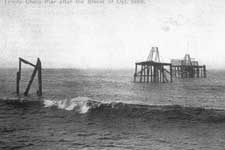The Chain Pier
On this page
Background
Before 1820, ships and boats on the Firth of Forth used Leith Docks (in 1820 only the two Old Docks, as they were later known, had been built) or Newhaven Harbour. With the increasing use of steamships a need was felt for another point where they could call, without the congestion caused by other vessels.
The construction is said to have been arranged by a Mr Parrot at a cost of £4,000.
The wider picture
A central figure in the building of the Chain Pier was Captain Samuel Brown. He served as a Royal Navy officer, and during his time in the Navy developed chains for use instead of the traditional hemp cables for rigging and anchors on Navy ships. He retired from the Navy in 1812 and set up a company to manufacture chains. In 1816 and 1817 he obtained patents for chains, and in 1817 designed Dryburgh Bridge, near Dryburgh Abbey in the Borders, Scotland. Unfortunately it collapsed, but it was rebuilt although the replacement also collapsed, in 1838.
In 1818 he designed a more successful bridge, the Union Bridge across the River Tweed between Horncliffe in England and Fishwick in Scotland. It was completed in 1820 and is still in existence.
Both these bridges were suspension bridges, with the weight of the deck being carried via hangers from chains supported on towers. The Forth Road Bridge is a more recent example nearby of a suspension bridge, but uses cables instead of chains.
Captain Brown went on to design a number of other bridges in the UK, as well as the Chain Pier at Trinity and another Chain Pier at Brighton ![]() . Captain Brown was later knighted by Queen Victoria.
. Captain Brown was later knighted by Queen Victoria.
There are excellent flypast animations of 3D computer models of Trinity Chain Pier and the Brighton Pier, both produced by Jean Hopkins, on Youtube – see the links below.
Where was it?
The pier was located at Trinity Crescent, extending out to sea from the north side of the street. The present Old Chain Pier Bar marks the point where it was. At the time the pier was built, only the first few houses on the crescent had been constructed and the crescent was never quite completed, a gap remaining adjacent to number 15.
Construction
The pier consisted of a timber deck suspended from chains which in turn were carried by timber towers. The towers were built off timber piles driven into the foreshore – the remains of a few can still be seen if the tide is very low. The lower part of the structure was fairly substantial, and was topped by platforms at deck level, and on them were built smaller towers to support the cables. The timber deck was quite narrow, only 4 feet (1.2 m) in width. The pier was about 650 feet (200 m) long.
The pier was opened on 14 August 1821 with a grand ceremony, including a trip on two steamers.
In use
From its opening in 1821 until the Granton Harbour opened in 1838, the Chain Pier was the main point from which steamer services on the Forth departed. Services continued after that, but at a reduced level, until the 1850s.
After that, the pier was used as a point from which swimmers could take to the water, some travelling by train from Edinburgh to Trinity Station nearby. A building at the seaward end of the pier was apparently used as a gymnasium.
Destruction
The Chain Pier was destroyed in a storm on 17 October 1898. It seems not to have been well maintained over the years, but the storm was a very severe one which caused a great deal of other damage. Ships were wrecked and driven aground, and much damage caused.
Brighton Chain Pier had been destroyed in 1896 in a storm.
Further information
The following two books contain more information about the Chain Pier:
| Title | Author | Publisher | Date | ISBN |
|---|---|---|---|---|
| Old Leith | Guthrie Hutton | Stenlake Publishing | 1995 | 1872074650 |
| Further Traditions of Trinity and Leith | Joyce Wallace | John Donald Publishers Ltd | 1990 | 0859762823 |
The first of these books contains the photographs which I have used by kind permission of the publisher, and many other old photographs of Leith.
The second, and a previous book by Joyce Wallace, ‘Traditions of Trinity and Leith’, contains much interesting information about the area.

